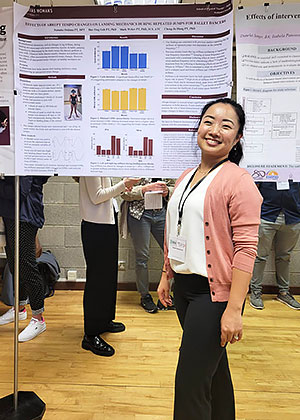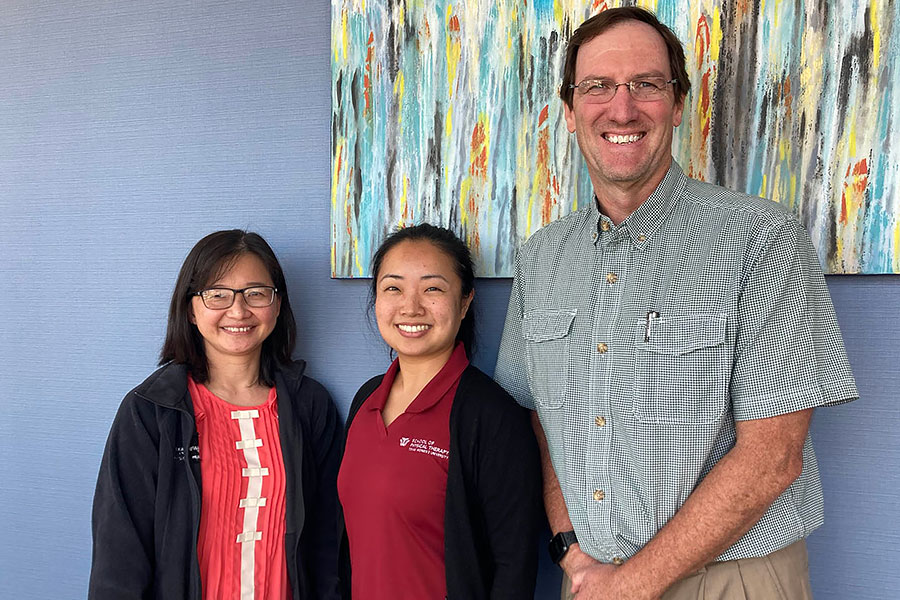Mixing science, dance helps alum find calling

January 19, 2023 — DALLAS — For five years, Natsuko Oshima, PT, DPT longed to attend the International Association for Dance Medicine and Science conference. Midterms and the pandemic had kept the Texas Woman’s alumna from attending, but the trip to Limerick, Ireland in October of 2022 proved to be worth the wait.
Not only was Oshima able to connect with other professionals with similar backgrounds, she also was one of 42 people selected to present at the annual conference, which is for dance science and medical professionals.
The icing on the cake was Oshima receiving the competition poster award at the closing ceremony. Her study focused on how effects of abrupt tempo changes in music affects the jumping mechanism of ballet dancers.
Oshima cried tears of happiness after seeing her name flash across the screen as the poster winner.
“I felt accepted,” Oshima said. “I finally found a community that I belong to. People understood my research, my true value and my passion.”
Oshima was a professional ballet dancer whose career was cut short due to injuries. She decided to pursue a second career in physical therapy to help others, especially dancers, rehabilitate their injuries. She received her doctor of physical therapy degree (DPT) at the TWU T. Boone Pickens Institute of Health Sciences - Dallas Center in May of 2022.
“It’s so hard to find people that can fully understand my research,” Oshima said. “You need to understand not only ballet as an art form, but also as movement. You also need to know the biomechanics and physical therapy aspects of it.”
When people back home would ask about her research, she would explain how important music was to ballet dancers. In classical ballet, music showcases dancers’ artistic expression but also determines the speed and frequency of dancers’ every movement.

People would nod their heads and say that was interesting.
Oshima could talk about her research with her family. Her mother is a piano teacher, her husband is a violinist and her mother-in-law is a ballet teacher, so they all understand the importance of music and tempo. However, they aren’t scientists.
On the other side, she was able to talk to her professors about the data and how to analyze movements quantitatively, but they do not know about the regulated quality of certain ballet movements or the life of a professional dancer.
During the conference, she had wonderful discussions about her research with so many professionals who understood both the art and science aspects of dance.
“So many people came up to me and asked me questions about my research,” Oshima said. “And they really said, ‘that’s interesting.’”
They understood that Oshima was introducing a unique point of view in an under researched area.
Oshima pursued this research on top of her studies at TWU. She worked with Hui-Ting Goh, PT, PhD, an assistant professor at the Dallas campus, whose support allowed Oshima to pursue a question that had always bugged her.
Why wasn’t music included as a common factor that could affect dancing injuries, especially for ballet dancers?
While an undergraduate student, Oshima produced a literature review for an independent study on music and its relationship to dance injuries. What she found was there wasn’t a lot of research.
"I always had the thought, if the time, place and resources were together, I wanted to do this type of research.”
Oshima's Research at TWU
All the pieces came together when Oshima was a second-year DPT student in Goh’s classroom. Students were introduced to the Gait Lab, which is a 3D motion analysis lab. Oshima realized the Vicon, a 3D motion capture system, was what she needed. Motion capture records movement of people or objects.
Goh encouraged Oshima to pursue her research, but she told Oshima she needed to start with the basics. First, she needed to analyze how music affects motion in dancers.
In order to analyze dancers’ movements with the Vicon system, Oshima attached markers to major body parts and joints, and multiple cameras recorded dancers’ movements. The Vicon system also included force plates, which are tools used to measure forces exerted on the ground during movement. The Vicon system used the data produced to describe and analyze movements both kinematically and kinetically.
From her data, Oshima found that when the music slows, dancers tend to adjust with a deeper plié, or a deeper squat. When the music is faster, the dancers dip into a shallower plié. Her findings were consistent with earlier studies that reported leg stiffness occurring after repeated jumps, dependent on jumping frequency.
"High levels of stiffness lead to increased risk of injury likely due to increased shock, peak force, and reduced joint motion in the lower extremities," Oshima said in her research. "Low levels of stiffness may also increase the likelihood of soft-tissue injury because of excessive joint motion."
In addition to the IADMS conference, she and Goh are presenting a second poster with additional data at the APTA Combine Section Meeting in February of 2023.
If the situation and the right PhD program presents itself, Oshima would like to continue her research. Right now she is focused on her job as a clinician at an out-patient orthopedic physical therapy clinic. Oshima is also starting her own business, Therapy En Pointe, LLC, that serves dancers, a mobile physical therapy clinic.
“My big dream is to make a protocol using the music to help ballet dancers rehab their injury,” Oshima said. “I would like to see music in their rehabilitation process, especially for the return to performance phase.”
Oshima has learned that good things are worth the wait.
Media Contact
Amy Ruggini
Digital Content Manager
940-898-3628
aruggini@twu.edu
Page last updated 11:22 AM, January 30, 2025